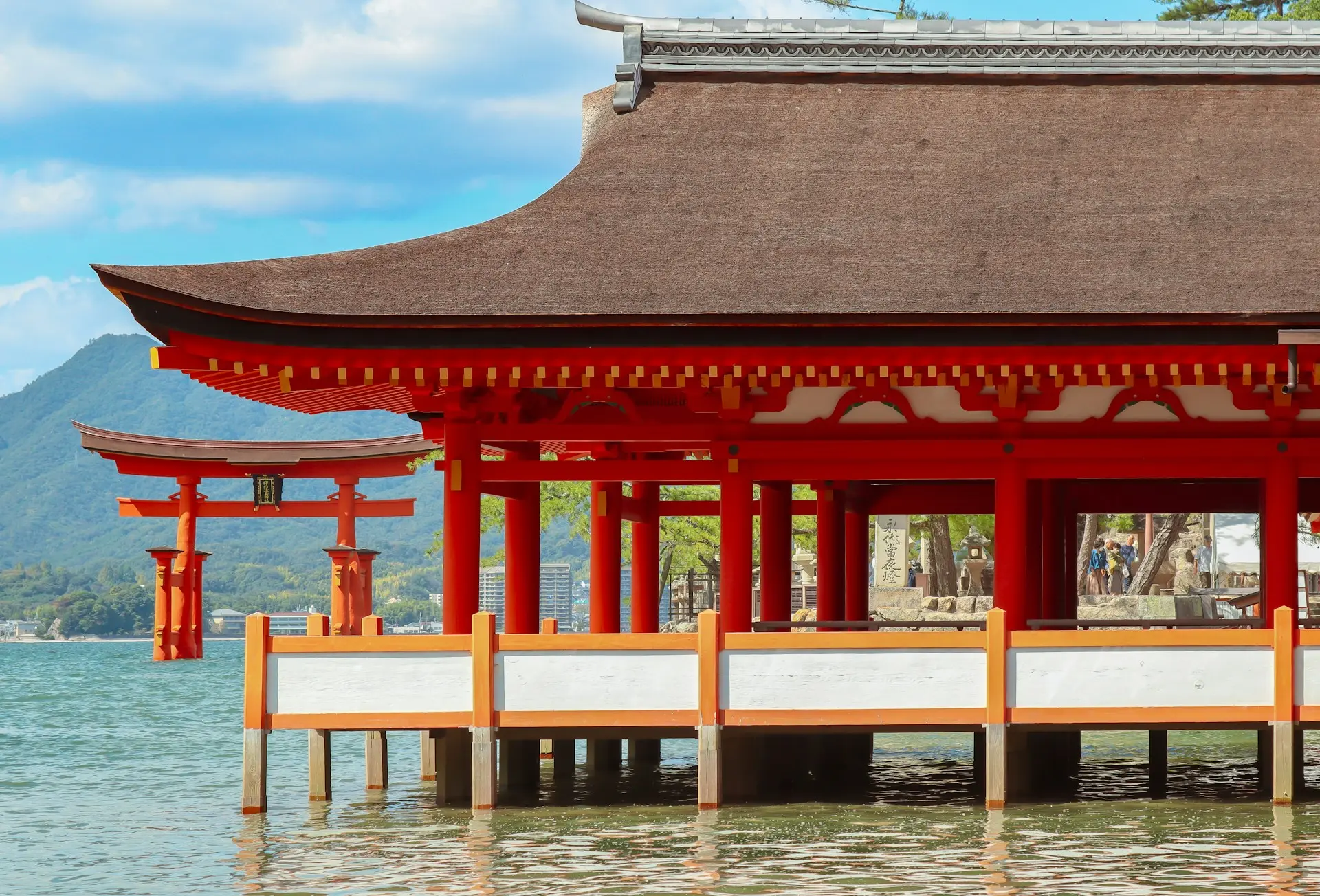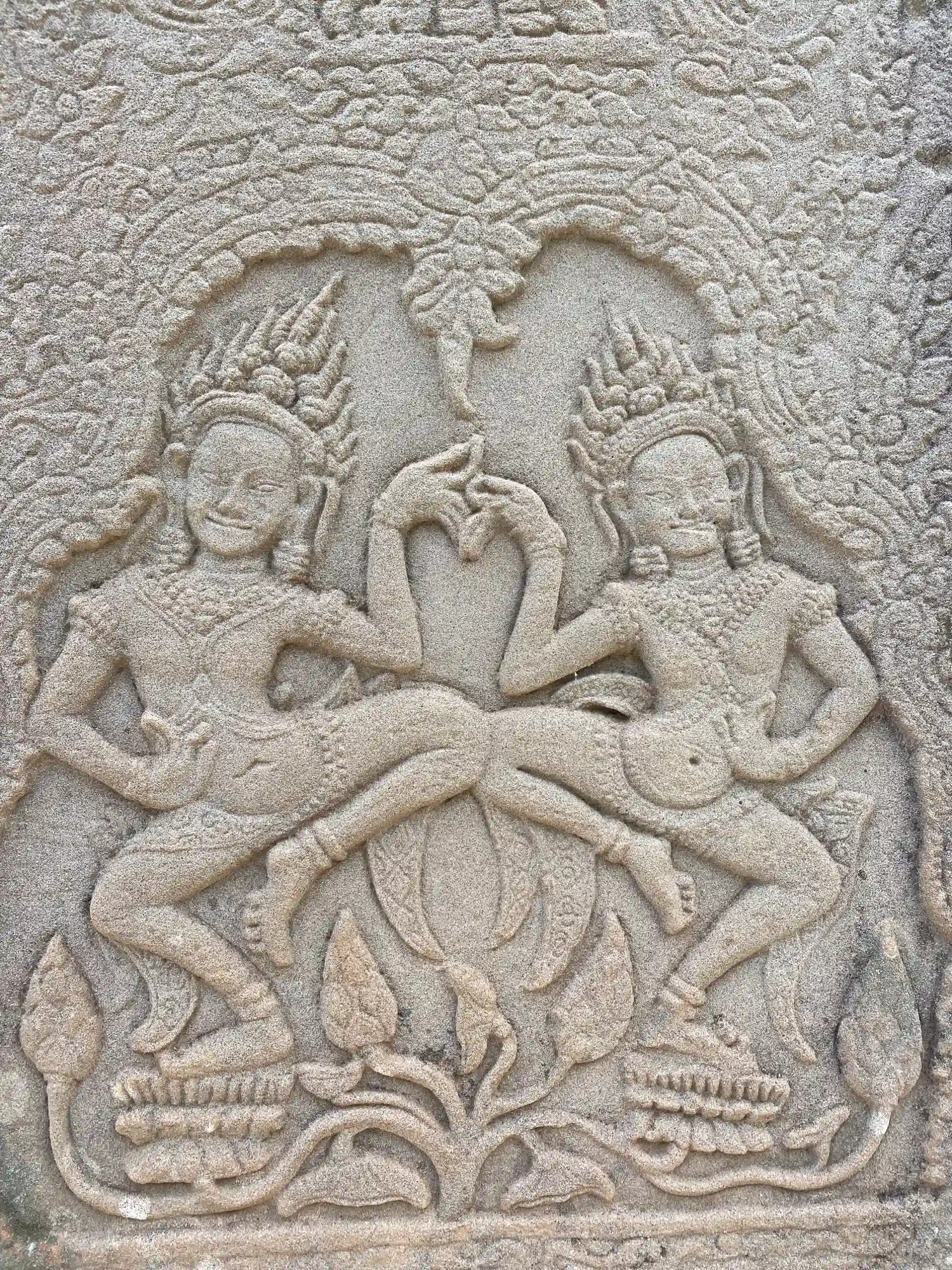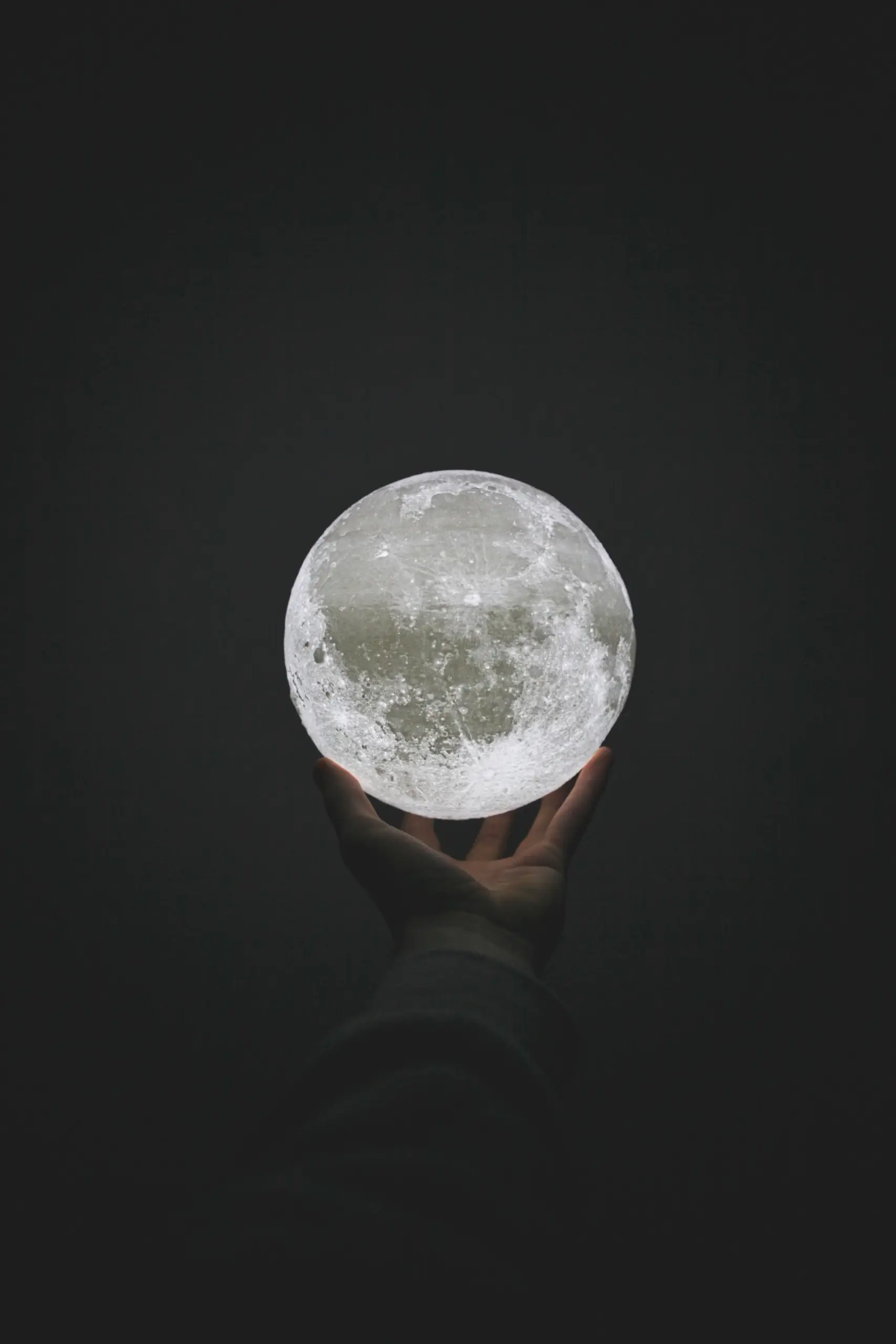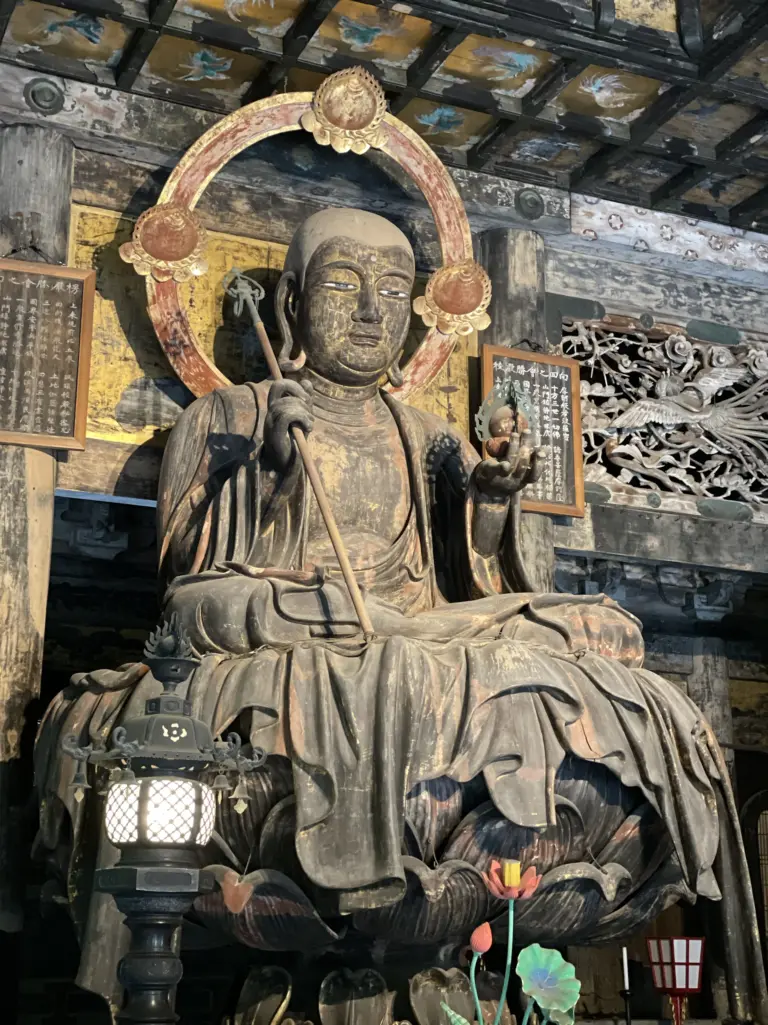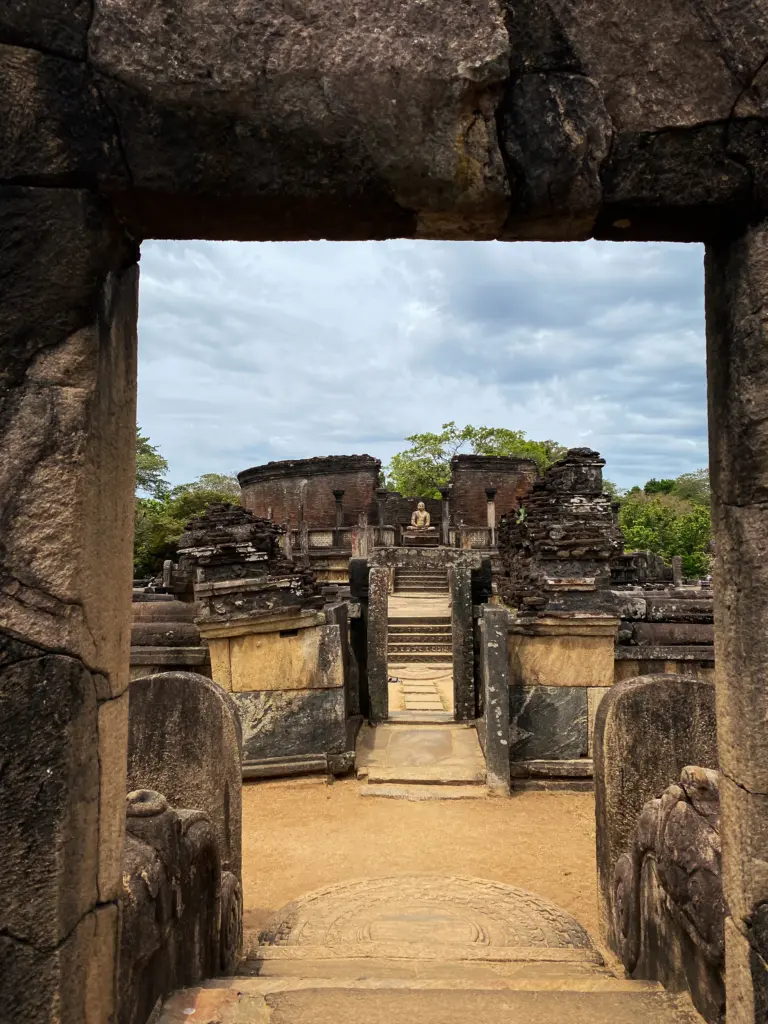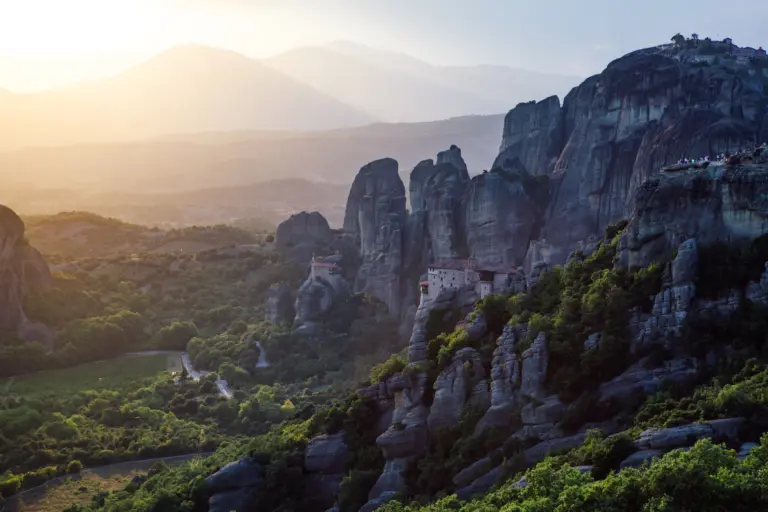Kusatsu is not your average Japanese town.
It’s a place where hot water bubbles up from the earth’s belly, creating some of the most famous hot springs in Japan. In fact, Kusatsu Onsen has been a beloved spa destination for centuries, and let me tell you, there’s a good reason for it.
First off, the amount of water gushing up here is unbelievable. We’re talking about one of Japan’s top three hot springs in terms of water volume. And it’s not just any water; it’s highly acidic, packed with healing properties that people have sworn by for ages. It’s said to cure everything but heartache!
Strolling through this charming town with steam rising from every nook and corner, is an experience in itself. And let’s not forget the nature surrounding Kusatsu. The town is nestled high in the mountains, offering stunning scenic views and plenty of hiking trails. (Check out Mt. Akagi as well if you’re hanging around in Gunma!)
In winter, which is my favorite time to go, the area transforms into a snowy wonderland, perfect for skiing and snowboarding!
Table of Contents
Toggle
History of Kusatsu
Tucked away in the mountains of Gunma, this quaint town has been a renowned hot spring destination for centuries!
The story of Kusatsu Onsen dates back over a thousand years, with mentions in ancient Japanese literature like the “Man’yoshu” and “Nihon Shoki.”
However, it was during the Edo period (1603-1868) that Kusatsu really began to flourish as a hot spring resort. Daimyo (feudal lords) and samurai would travel from distant lands to soak in the therapeutic waters.
In the 19th century, Kusatsu’s fame reached new heights thanks to Dr. Erwin von Baelz, a German physician who served the Imperial family. Dr. Baelz, impressed by the quality of Kusatsu’s hot springs, began recommending them for health benefits, leading to an influx of international visitors and increased recognition.
Top Things to Do in Kusatsu

1. Stroll Around Yubatake
Ah, the Yubatake! It’s the beating heart of Kusatsu and a sight you simply can’t miss.
Yubatake, which translates to “hot water field”, is essentially the centerpiece of Kusatsu’s hot spring culture. It’s this steaming, bubbling pool right in the middle of the town. And it’s not just there for show – it plays a crucial role in distributing the hot spring water to the various bathhouses and ryokans around town.
What’s really cool about the Yubatake is how it symbolizes the abundance of Kusatsu’s hot springs. This spot alone accounts for a significant amount of the total hot spring water flowing in the town. The water here is super hot, like over 70°C (158°F).
To make it suitable for bathing, they cool it down through a unique wooden conduit system. It’s like a natural, geothermal water distribution center.
The Yubatake is also a visual spectacle, especially at night when it’s beautifully lit up. The steam rising against the backdrop of lights creates this almost mystical atmosphere.
Around the Yubatake, you’ll find numerous foot baths where you can dip your feet and relax. There’s also a range of shops and eateries where you can try local delicacies or pick up some onsen-related souvenirs.

2. Explore Sainokawara Park
Another pleasant surprise was Sainokawara Park. This was not just an ordinary park but a geothermal park with the smell of sulfur in the air. There was a lot of really cool water bodies and with the snow, the landscape was absolutely breathtaking.
The path to the Sainokawara Rotenburo (outdoor bath) takes you through Sainokawara Park. A stone-paved promenade winds its way past several popular sightseeing spots. These include the Anamori Inari Shinto shrine, the Oni no Chagama monument, the Matchmaking Jizo statues, and the Kusatsu Visitor Center.
3. Take a Dip at Sainokawara Rotenburo
The Sainokawara Rotenburo is fed by the Bandai hot springs, which are known for their rich mineral content. The waters here are drawn directly from the Yubatake.
They’re quite special because they contain acid, sulfur-containing aluminum sulphate, and chloride. The pH values of these waters range between 1.7 and 2.1, and the temperatures vary from 51°C – 94 °C (124°F – 201°F).
The rotenburo itself is impressively large, covering 500 square meters. It’s designed to comfortably accommodate up to a hundred people, to give you an idea of its size. There are separate areas for men and women as well.
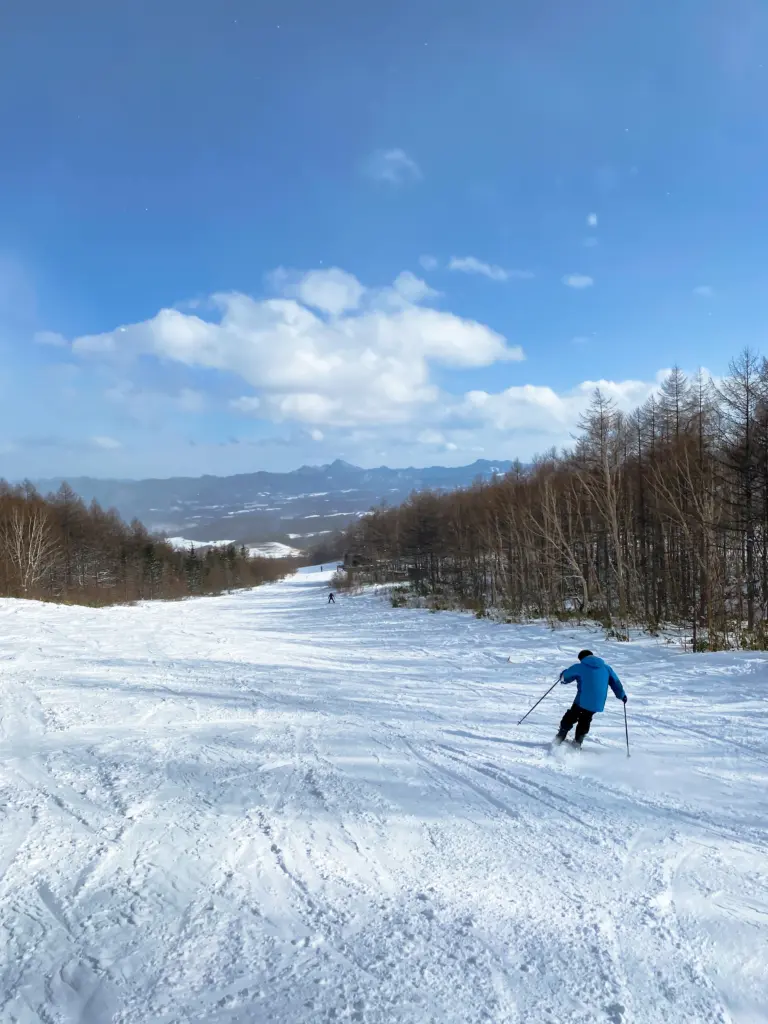
4. Shred Some Powder at Kusatsu Onsen Ski Resort
Kusatsu Onsen Ski Resort is a fantastic destination for ski enthusiasts and anyone looking to enjoy the beauty of winter in Japan.
One of the key attractions of Kusatsu Onsen Ski Resort is its variety of ski routes. Catering to all skill levels, from beginners to advanced skiers, the resort features well-maintained slopes with varying degrees of difficulty. Personally though, I found it to be quite short for the steep and challenging runs. There’s a very long section but it’s mostly flat-ish and it’s more like a leisurely stroll around the forests. It’s certainly no Niseko, that’s for sure.
It’s worth noting that the Kusatsu Onsen Ski Resort experienced a significant change following an unexpected volcanic eruption in January 2018. This led to the closure of the upper part of the ski resort, including the main gondola lift. Despite this, the resort continues to operate, offering multiple lifts and runs in its lower section.
After a day on the slopes, what could be better than unwinding in one of Kusatsu’s famous hot springs? The combination of thrilling ski slopes and rejuvenating onsen baths is what makes Kusatsu Onsen Ski Resort stand out.

5. Go on a Day Trip to Tsumagoi
If you’re not satisfied with Kusatsu’s Ski Resort, head on to Tsumagoi.
Tsumagoi Palcall Ski Resort is another awesome place to shred. Following a significant revamp in recent years, the resort has emerged as a favorite among ski enthusiasts.
With its wide, gently sloping runs and with a descent of up to 640 m (2,100 ft), Tsumagoi can definitely provide you with a ski experience that would beat Kusatsu. At the top (2,100 m / 6,890 ft), you can find snow monsters or snow covered trees all around you as you slide down.
There’s also the terrain park, known for its innovative design, rapidly gaining a reputation as one of the best in the region.
6. Get a Massage
You’ve spent the day gliding down the snowy slopes, feeling the rush of the cool air and the thrill of the descent. Your muscles have worked hard, and now it’s time to reward them. Or perhaps you’re planning to visit one of the many onsens and want to fully relax before taking the plunge into the healing waters. In either scenario, a massage is an ideal way to elevate your sense of well-being.
I recommend Rifurakku Kusatsu Onsen, they have affordable rates as compared to the more high-end and spa-like places. A quick 30-minute session, priced at 1,980 JPY and a 60-minute massage, at 3,980 JPY.
You can find them here, near Yubatake.

7. Watch the Yumomi
In the Yubatake area was the famous Yumomi which was an entertaining show put on by the ladies in traditional yukata as they sang, danced and beat paddles to the rhythm of music.
Yumomi itself is a traditional method of cooling down the hot spring waters in Kusatsu, and it’s an experience you definitely shouldn’t miss when you’re in town.
The waters in Kusatsu are naturally very hot, often too hot for bathing. In the past, and even today as a cultural practice, locals used the Yumomi technique to cool the water to a more comfortable temperature without diluting its mineral-rich properties with cold water. This method preserves the natural qualities of the onsen waters, which are celebrated for their health benefits.
Yumomi involves large wooden paddles used to stir and cool the water. A group of people, standing around a large, traditional hot spring bath, rhythmically moving these paddles through the water. They chant and work in unison, creating a mesmerizing dance-like performance.
You can watch the Yumomi performances at the Netsunoyu bathhouse for 600 JPY.
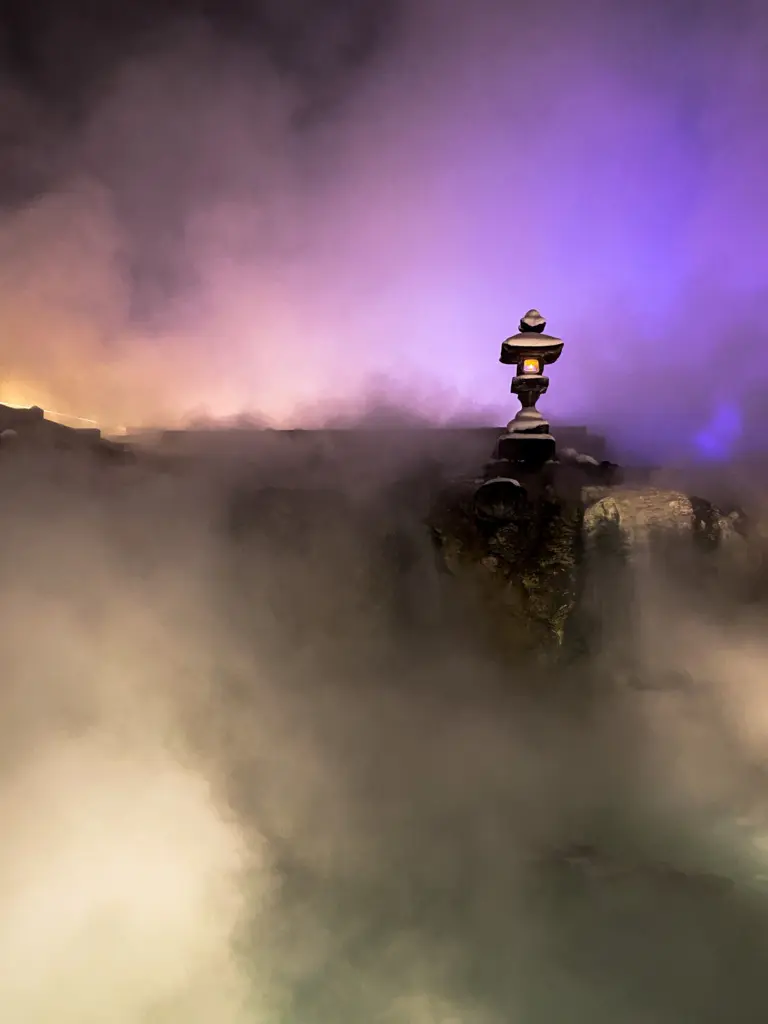
8. Enjoy the Winter Illuminations
As the cold months settle in, Kusatsu comes alive with twinkling lights and festive decorations!
Most of the winter illuminations can be found around the Yubatake area. You’ll find the area is adorned with thousands of lights that illuminate the steam and water, casting a spellbinding glow that reflects off the snowy surroundings. The contrast of the warm steam against the cold air, accentuated by the gentle glow of lights, makes for an ethereal sight as seen in the photo above.
You’ll also find a giant Christmas tree and some tiny igloos housing decorations and candles inside, totally romantic!
9. Have Fun at Kusatsu Forest Stage
Kusatsu Forest Stage, located within the grounds of Nakazawa Village resort, is an exhilarating outdoor amusement zone that promises adventure amidst the natural beauty of Kusatsu.
With 42 different activities to choose from, it boasts one of the largest collections of its kind in the country. This diversity ensures that everyone, regardless of age or skill level, can find something enjoyable.
The full course at the Forest Stage stretches an impressive 640 m (0.4 mi) and reaches heights of over 10 m (32 ft) above the ground. You can climb obstacles among the trees, testing your agility and strength while being surrounded by the serene beauty of the forest.

10. Meet Animals at Kusatsu Tropical Wonderland
Kusatsu Tropical Wonderland, also known as Kusatsu Nettaiken, stands out as the highest zoo in Japan, nestled at an elevation of 1,165 m (3,822 ft). This slightly rare facility is celebrated for being Japan’s number one zoo for reptiles. It houses over 300 species, including mammals, birds, reptiles, amphibians, and fish, primarily from sub-tropical regions, offering a rich and diverse glimpse into the animal kingdom.
A key feature is the giant tropical jungle dome, a 15-meter-tall structure crafted to mimic a tropical jungle. It cleverly uses the heat from local hot springs to maintain a suitable environment for its inhabitants.
The zoo also offers hands-on animal interactions, where visitors get the chance to touch and engage with plant-eating animals like capybaras, small pygmy marmoset monkeys, and certain reptiles.
As the leading zoo for reptiles in Japan, Kusatsu Nettaiken boasts many rare species, including the unique mata mata turtle and various poisonous snakes.
To be honest, my friend went to this place but when I checked the photos, it doesn’t seem like the animals have much space and cages are always sad. If you’re coming with kids, I’m sure they would enjoy it nevertheless.
11. Relax at Otaki no Yu
Known as the “hot spring of beauty,” Otaki no Yu has a creamy indoor pool, two outdoor ones, a set of four pools plus a hinoki pool by the showers.
The four pools I was talking about it known as the traditional awase-yu bathing culture. This involves bathing in several hot spring baths, each progressively hotter than the last. This method, deeply rooted in Japanese bathing traditions, allows bathers to gradually acclimate to the increasing temperatures. The awase-yu baths vary from 38°C (100°F) to 46°C (115°F). What’s remarkable is that these temperatures are maintained naturally, without diluting the water.
The water at Otaki no Yu is drawn from the Nikawa hot spring source, known for its acidic sulfur content. The 100% natural, free-flowing baths have been a favorite for their reputed benefits for skin health.
Every second and fourth Saturday of the month, Otaki no Yu has special “cloudy water” days. During these times, the hot spring deposits are cleaned from the piping, resulting in water that’s rich in minerals.
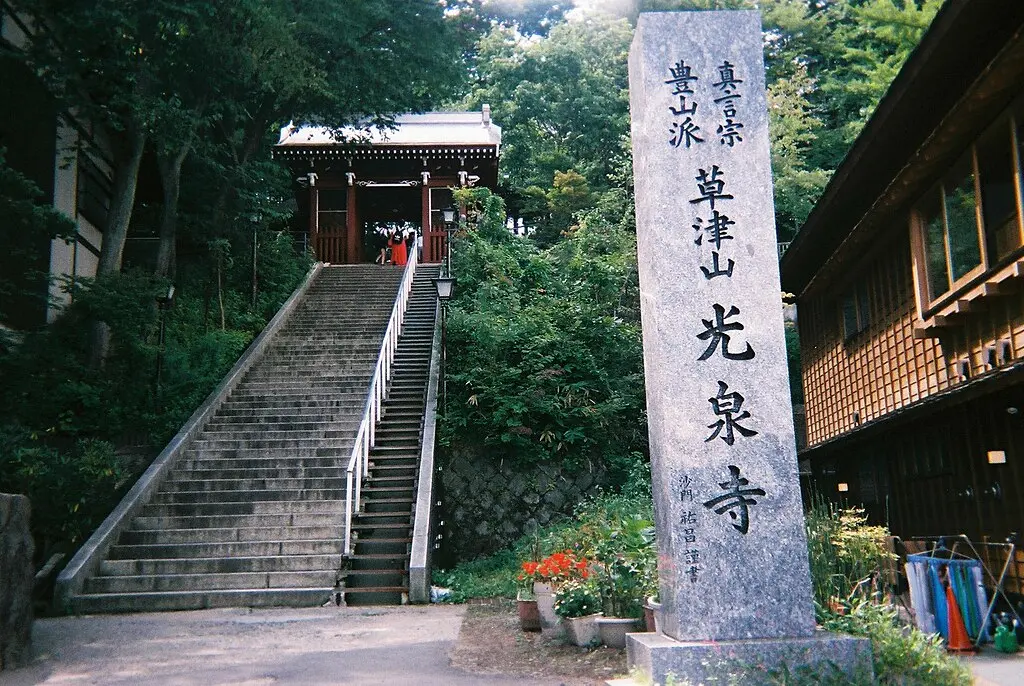
12. Visit Kosenji Temple
Nestled on a hill above Yubatake, Kosenji Temple is not only a place of worship but also a site that celebrates the glory of Kusatsu’s famous hot springs.
One of the most notable features of Kosenji Temple is its homage to the revered Edo Period Haiku Poet Issa Kobayashi. Kobayashi, who lived from 1763 to 1827, visited Kusatsu Onsen three times from Tokyo. His experiences in Kusatsu inspired him to pen several haikus, capturing the essence of the hot springs and their ethereal beauty. One such haiku goes:
“Through the steam, Clearly seen, The shape of the moon.”
In addition to Issa Kobayashi’s monument, the temple also features a tribute to another famous haiku poet, Matsuo Basho. Basho also praised the healing properties of Kusatsu’s waters through his poetry.
13. Zipline with BanZip Tengu
With BanZip Tengu, you’ll glide through the air from the peak of Tenguyama at an impressive altitude of 1,370 m (4,495 ft).
Ziplining across such a high altitude offers a heart-pumping, scream-inducing adventure that’s unlike any other in Kusatsu. As you zip across the sky, you’ll have a bird’s-eye view of the picturesque landscape below. The panoramic views of the surrounding area, with its lush greenery, rugged terrain, and the distant sight of hot springs.
With prices at 2,000 JPY, it’s an accessible and affordable thriller!

Where to Stay in Kusatsu
Having had the pleasure of visiting Kusatsu three times for three consecutive years, I can safely say that I have grown quite accustomed to the area. Most of the hotels and ryokans are close to the Yubatake area and even for those further out which might require a 15 – 20 minute walk to the city center, there are often shuttle services available. Here are my recommendations on where to stay:
Best Hotels in Kusatsu:
- Kusatsu Now Resort Hotel – two out of the three times, I stayed at Kusatsu Now Resort. It’s got tons of facilities including tennis courts and natural hot spring baths (the outdoor baths are particularly Zen). The resort boasts rooms with large windows providing views of nature, all equipped with air conditioning, LCD TVs, electric kettles, and feather duvets, along with a private bathroom complete with amenities and a bathtub. Complimentary WiFi is available throughout the property. You can also take advantage of the free bus service from Yubatake. Additional facilities include massage services and karaoke for relaxation and entertainment. Dining options include the Jurin Garden Restaurant, which offers a generous buffet spread for both breakfast and dinner.
- Itoen Hotel Kusatsu – nestled amidst scenic mountain views, Itoen Hotel Kusatsu was where I most recently stayed. And I have to say that it also delivers, it’s not as modern as Kusatsu Now Resort but the facilities were still top notch including the onsen, pool, and massage. You’ll have access to a shared lounge, on-site parking, and a 24-hour front desk for convenience. The accommodation includes comfortable rooms with flat-screen TVs, shared bathrooms equipped with slippers, hairdryers, and bidets. Each unit is furnished with a kettle, air conditioning, and a safety deposit box. For dining, the ryokan offers a family-friendly restaurant, and there’s a mini-market on-site for quick needs.
- Kusatsu Onsen Eidaya – offers you the luxury of a private hot spring bath and an on-site Japanese restaurant. Accommodations at the ryokan are well-equipped with amenities including a flat-screen TV, fridge, and wardrobe. You can start your day with an Asian breakfast served each morning. For leisure, there’s a shared lounge area at the ryokan where you can engage in various activities, including game consoles, board games, and playing cards. The location is ideal for those looking to enjoy outdoor activities, particularly skiing, in the scenic surroundings of Kusatsu.

How to Get Around Kusatsu
Kusatsu is a small town, and many of its main attractions, like the Yubatake, Sainokawara Park, and numerous onsens, are within walking distance of each other. But still, there are also other means of transportation to get around Kusatsu:
- Bus: For attractions that are a bit further away, such as some ski resorts or distant onsens, local buses are available. Bus schedules and routes are typically available at hotels, tourist information centers, and bus stations.
- Shuttles: Many hotels and ryokans in Kusatsu offer shuttle services to and from local points of interest, particularly ski resorts in the winter. There are also free shuttle bus services running from Yubatake to other hotels around the area.
- Taxis: Taxis are available and are a quick way to get around, especially if you’re traveling in a group or with lots of gear.
- Rental Car: If you plan to visit surrounding areas such as Tsumagoi, rental cars are a great option.

Best Time to Visit Kusatsu
I may be biased since I’ve only ever been there during winter, all three times to boot! But definitely visiting Kusatsu during the winter months (December to February) is truly a magical experience. Winter transforms the town into a picturesque wonderland with sparkling light-ups.
In winter, Kusatsu is blanketed in snow, creating a stunning contrast with the warm steam rising from the onsen waters. This snow-clad scenery is not only breathtaking but also adds a serene touch to the town’s atmosphere. Temperatures during this season can drop significantly, often ranging from -5°C to 5°C (23°F to 41°F), which makes the warmth of the onsen baths even more inviting.
Plus, think about all the ample opportunities for skiing and snowboarding!
How to Get to Kusatsu
Getting to Kusatsu Onsen can be conveniently achieved through various means of transportation from Tokyo. Here are the primary options:
1. Train and Bus Via Naganohara
From Tokyo to Naganohara-Kusatsuguchi:
- The most convenient option is a direct limited express train from Tokyo’s Ueno Station. This takes about 2.5 hours and costs approximately 5000 JPY one way. There are around three round trips per day.
- An alternative is using local trains, which take about 4 hours and cost 3080 JPY one way, with a transfer at Takasaki.
- A faster, more expensive option involves taking the shinkansen to Takasaki and then transferring to a local train to Naganohara-Kusatsuguchi.
From Naganohara-Kusatsuguchi Station:
- From Naganohara-Kusatsuguchi, take JR buses to Kusatsu Onsen, which takes about 30 minutes and costs 710 JPY.
- While the train journey is covered by several Japan Rail Passes, but note that only specific passes cover the bus ride.
2. Train and Bus Via Karuizawa
- Shinkansen to Karuizawa:
- Take the Hokuriku Shinkansen from Tokyo to Karuizawa. This journey takes about 70 minutes and costs around 5500 JPY.
- From Karuizawa, catch a bus (Seibu Bus or Kusakaru Kotsu) to Kusatsu Onsen. The bus ride is approximately 80-100 minutes and costs 2240 JPY.
- Note that JR passes are not valid on the buses between Karuizawa and Kusatsu.
3. Highway Bus
- From Tokyo to Kusatsu:
- Multiple JR highway buses run from Tokyo (Busta Shinjuku) to Kusatsu each day. The journey takes about 4 hours and costs around 3500-4000 JPY, varying by travel date.
- JR passes are not valid on these buses.
- Additionally, some other bus companies operate services between Shibuya (Mark City) and Kusatsu. These buses take about 4.5 hours and cost 3600 JPY one way, with reservations available online via Willer.
Plan Your Trip to Kusatsu | Best Travel Resources
Book Your Accommodations
- Booking.com – the world’s leading online booking platform for accomodations around the world, they have an extensive amount of available listings with zero booking fees and best price guarantees.
- Hostelworld – a backpacker’s best friend, Hostelworld has the largest collection of hostels and guesthouses for affordable prices.
Don’t Forget Insurance
- SafetyWing – from Nomad Insurance, an insurance by nomads for nomads. They understand our lifestyle well and have really comprehensive and flexible plans that cater to any traveler.
Find Cheap Flights
- Kiwi.com – my go-to for booking and finding the cheapest flights and it’s helped me save tons of money. They do virtual interlining which is connecting flights from airlines that do not codeshare, so you can find routes that you wouldn’t be able to find normally.
Join Tours & Activities
- GetYourGuide – is one of the best places to find unique tours and activities. I found that it’s an excellent way to meet fellow travelers and create fond memories. They are not only limited to tours as they also offer niche services such as skip-the-line tickets or private transfers.
Catch a Ride
- Rentalcars.com – nothing beats the freedom of the road, Rentalcars.com is the world’s largest online car rental service. They operate across 160 countries so they’re the perfect partner to work with if you find yourself wanting a ride.

